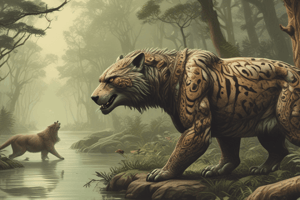Podcast
Questions and Answers
In an ecosystem experiencing a population crash after the removal of a keystone predator, which of the following scenarios is most likely to occur?
In an ecosystem experiencing a population crash after the removal of a keystone predator, which of the following scenarios is most likely to occur?
- A temporary increase in the prey population followed by a sharp decline due to resource depletion. (correct)
- Increased biodiversity as more niches become available.
- A shift in the ecosystem towards greater resilience and resistance to future disturbances.
- Stabilization of the ecosystem at a new equilibrium with higher carrying capacities for all species.
A population of bacteria exhibits J-shaped growth initially. What factor will most likely cause this growth pattern to shift to S-shaped growth?
A population of bacteria exhibits J-shaped growth initially. What factor will most likely cause this growth pattern to shift to S-shaped growth?
- The population reaching the carrying capacity of its environment, leading to increased mortality. (correct)
- The introduction of a new, unlimited resource into the bacteria's environment.
- A decrease in competition for resources among individual bacteria.
- A sudden increase in the rate of reproduction within the bacterial population.
Wild sheep inhabit a mountainous forest. Scientists observe that as the sheep population density increases, lamb survival rates decrease. This is most likely due to:
Wild sheep inhabit a mountainous forest. Scientists observe that as the sheep population density increases, lamb survival rates decrease. This is most likely due to:
- An increase in density-dependent factors such as heightened competition for resources and increased disease transmission. (correct)
- An increase in density-independent factors like natural disasters.
- An increase in the carrying capacity of the forest ecosystem.
- A decrease in density-dependent factors like disease transmission and resource competition.
A forest ecosystem with a stable population of deer suddenly experiences a surge in the deer population due to decreased wolf presence. Which of the following outcomes is most likely in the long term?
A forest ecosystem with a stable population of deer suddenly experiences a surge in the deer population due to decreased wolf presence. Which of the following outcomes is most likely in the long term?
A population density graph shows a steep decline in the survival rate of a certain species as its population density increases. Which of the following factors is most likely responsible for this trend?
A population density graph shows a steep decline in the survival rate of a certain species as its population density increases. Which of the following factors is most likely responsible for this trend?
Which of the following best describes the concept of homeostasis in an ecosystem?
Which of the following best describes the concept of homeostasis in an ecosystem?
In a predator-prey relationship, what is the most likely outcome of a significant and sustained decrease in the predator population?
In a predator-prey relationship, what is the most likely outcome of a significant and sustained decrease in the predator population?
What is the primary factor that dictates the cyclic pattern observed in a typical predator-prey population graph?
What is the primary factor that dictates the cyclic pattern observed in a typical predator-prey population graph?
Considering a forest ecosystem with wolves and deer, what would be a likely consequence of introducing a non-native disease that specifically targets and decimates the deer population?
Considering a forest ecosystem with wolves and deer, what would be a likely consequence of introducing a non-native disease that specifically targets and decimates the deer population?
If a forest ecosystem experiences a prolonged drought, what would be the most likely initial effect on the local deer and wolf populations?
If a forest ecosystem experiences a prolonged drought, what would be the most likely initial effect on the local deer and wolf populations?
Flashcards
Ecosystem
Ecosystem
All living and non-living things in an environment, striving for balance.
Homeostasis
Homeostasis
Maintaining a stable internal environment despite external changes.
Population Graph
Population Graph
Shows changes in a population of organisms over a period.
Predator-Prey Relationship
Predator-Prey Relationship
Signup and view all the flashcards
Predator-Prey Graph
Predator-Prey Graph
Signup and view all the flashcards
Keystone Species
Keystone Species
Signup and view all the flashcards
Carrying Capacity
Carrying Capacity
Signup and view all the flashcards
J-Shaped Growth
J-Shaped Growth
Signup and view all the flashcards
S-Shaped Growth
S-Shaped Growth
Signup and view all the flashcards
Study Notes
- An ecosystem includes all living and non-living things in an environment.
- Ecosystems strive to maintain a balance called homeostasis.
- Changes in one species' population affect others.
- Population graphs illustrate population changes over time.
Predator-Prey Relationships
- Predators hunt prey as a food source.
- Predator-prey relationships need to maintain a particular ratio to achieve homeostasis.
- In the forest, wolves prey on deer, which eat grass.
- When grass is abundant, deer populations increase and then the wolf population increases.
- As wolf populations increase, the deer population decreases, leading to a subsequent decrease in the wolf population.
- Predator and prey populations increase and decrease together in a cyclic pattern.
- If the wolf population declines indefinitely (e.g., due to hunting or habitat destruction), the deer population increases and consumes all the grass.
- Afterward, the deer population goes up due to lack of predators but declines when they exhaust their food source (grass).
- A population crash happens when species populations decrease suddenly.
- A population crash can occur from the decline of a keystone species like the wolf, potentially leading to extinctions.
- The wolf is a keystone species, and an important regulator.
Carrying Capacity
- Environments can only support a maximum population of organisms, which is called the carrying capacity.
- When a population exceeds the carrying capacity, organisms die until homeostasis is restored.
- Bacteria populations can grow exponentially (J-shaped growth).
- Bacteria populations eventually reach a point where the environment can no longer sustain them, leading to a die-off until carrying capacity is reached (logistic or S-shaped growth).
- Populations go through exponential growth until reaching carrying capacity.
Population Density Graphs
- Population density graphs show how factors are affected by changes in population density (number of organisms per unit area).
- Higher density leads to greater competition for resources.
- As population density increases, the survival rate of lambs decreases.
- Factors such as disease and competition for resources are density-dependent, influencing populations based on density.
- In denser populations, disease spreads more easily.
Studying That Suits You
Use AI to generate personalized quizzes and flashcards to suit your learning preferences.




